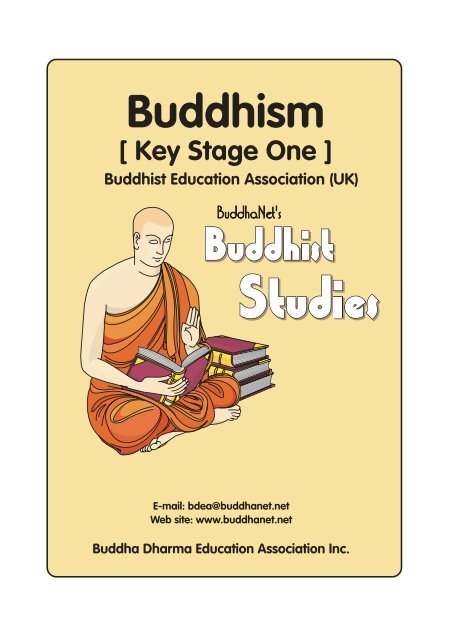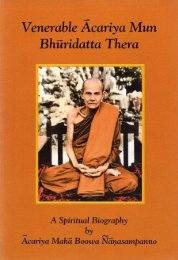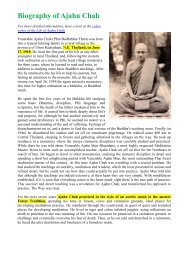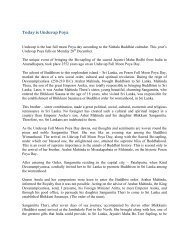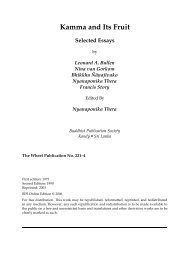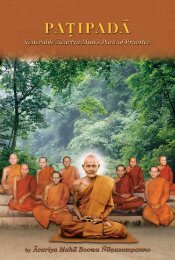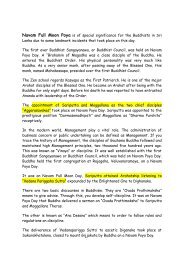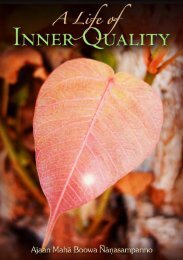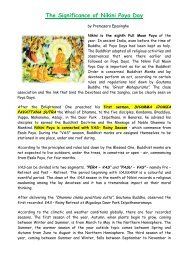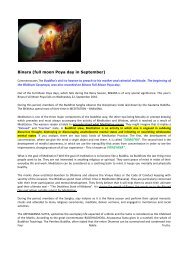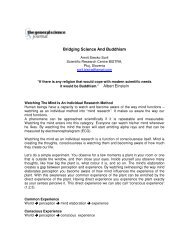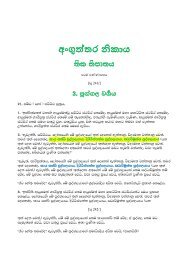Create successful ePaper yourself
Turn your PDF publications into a flip-book with our unique Google optimized e-Paper software.
<strong>Buddhism</strong>[ <strong>Key</strong> <strong>Stage</strong> One ]Buddhist Education Association (UK)E-mail: bdea@buddhanet.netWeb site: www.buddhanet.netBuddha Dharma Education Association Inc.
ByJing YinKen HudsonPublished byBuddhist Education Foundation (UK)Registered Charity No.: 10730082000
First published in Great Britain in 2000byBuddhist Education Foundation (UK)This is a complimentary Buddhist textbook,which can be obtained fromThe Buddhist Education Foundation (UK)BCM 9459London WC1N 3XXUnited Kingdomwww.buddhisteducation.co.ukinfo@buddhisteducation.co.ukRegistered Charity No.: 1073008ISBN 0 9536928 0 9Illustrated by Yanfeng LiuProduced by media 2000
PrefaceThe present publication constitutes the first out of fourtextbooks on <strong>Buddhism</strong> devised for children betweenfive and seven years of age. The primary aims of thesetextbooks are to help young pupils to acquire theessential knowledge about the life of the Buddha, hisfundamental teaching and the historical developmentof <strong>Buddhism</strong>. The information is basically factual,although it places a marked emphasis on the salientcharacter of Buddhist morality and its constructiveattitude towards people and society.<strong>Buddhism</strong> for <strong>Key</strong> <strong>Stage</strong> One provides an introductionto the basic concept of the Triple Gem, namelythe Buddha, the Dharma and the Sangha. These threeelements constitute the three pillars of <strong>Buddhism</strong>.The Buddha is the founder and teacher, the Dharmarepresents the Buddha’s teachings, and the Sanghadenotes the Buddhist community as a whole, living inaccordance with the Buddha’s teachings. In additionto these three elements covered in separate chapters,the textbook also includes ten selected Buddhist stories,which are to serve as additional aids to help the pupilsgain a better grasp of Buddhist principles and see theirapplication in various contexts.The accompanying Pupil’s Workbook containsvarious types of exercises based on standard teachingmethods. They are intended for revision purposes andshould be used at the discretion of the teacher. The5
English grammar and vocabulary are adapted to the levelof an average pupil of <strong>Key</strong> <strong>Stage</strong> One. However, somepupils may need further assistance with the reading ofthis book. All Buddhist terms, printed in blue, (whichare hyperlinked in this PDF) are listed in the glossary.The subjects covered in this and the remainingissues of this series are in accordance with the syllabusprescribed in the UK by the revised National Curriculumin 1994.This textbook is produced by the Buddhist EducationFoundation. It is a charitable organisation whichaims to promote the education of <strong>Buddhism</strong> in thiscountry.The authors of the text are Jing Yin and Ken Hudson.Jing Yin is a Buddhist monk from China. He studied<strong>Buddhism</strong> in China and Sri Lanka. Currently he is inhis final year of his Ph.D. programme at the School ofOriental and African Studies, University of London. Heis being supervised by Dr T. Skorupski, who has alsobeen consulted in matters relating to this textbook. KenHudson has taught in Australia, Canada and England formore than 20 years. Liu Yanfeng, a professional artist,has done the illustrations.We would appreciate receiving feedback from bothteachers and pupils about this first edition with a viewto improving the material for the next editionPresidentThe Buddhist Education Foundation (UK)6
ContentsPreface . . . . . . . . . . . . . . . . . . . . . . . . . . . . . . . . . . . . . . . . . . 5The Buddha . . . . . . . . . . . . . . . . . . . . . . . . . . . . . . 9The Dharma . . . . . . . . . . . . . . . . . . . . . . . . . . . . . 27The Sangha . . . . . . . . . . . . . . . . . . . . . . . . . . . . . . 37The Triple Gem . . . . . . . . . . . . . . . . . . . . . . 42Buddhist Stories . . . . . . . . . . . . . . . . . . . 47Wild Deer ParkNo killing . . . . . . . . . . . . . . . . . . . . . . . . . . . . . . . . . . . . . 48The Moon is Looking at YouNo stealing . . . . . . . . . . . . . . . . . . . . . . . . . . . . . . . . . . . 50The Buddha and RahulaNo lying . . . . . . . . . . . . . . . . . . . . . . . . . . . . . . . . . . . . . . . 527
The Young Deer that Played DeadRespecting Teachers . . . . . . . . . . . . . . . . . . . . . 54The Buddha Threading the NeedleHelping each other . . . . . . . . . . . . . . . . . . . . . . . 56The Crippled Man & the Blind ManHelping each other . . . . . . . . . . . . . . . . . . . . . . . 58The Fishmonger’sMaking good friends . . . . . . . . . . . . . . . . . . . . . 60The Fox and the OttersDo not be selfish . . . . . . . . . . . . . . . . . . . . . . . . . . . 62The Snake’s Head and TailDo not fight with each other . . . . . . . . . 64The Cleaning WomanClean mind . . . . . . . . . . . . . . . . . . . . . . . . . . . . . . . . . . 66Glossary . . . . . . . . . . . . . . . . . . . . . . . . . . . . . . . . . . . . . . . 68Index . . . . . . . . . . . . . . . . . . . . . . . . . . . . . . . . . . . . . . . . . . . . 69Bibliography . . . . . . . . . . . . . . . . . . . . . . . . . . . . . . . . 708
The BuddhaTian Tan Buddha Statue in Po Lin Monastery Hong Kong<strong>Buddhism</strong> is the teachings of the Buddha.He was a wise teacher. His teachings helppeople to live wisely and happily. Today,more than 500 million people in the worldfollow his teachings. In this unit, we aregoing to tell you the story of the Buddha.9
About 2,600 years ago, there lived a greatking named Suddhodana. He had a prettywife called Maya. They lived at the bottomof the Himalayan Mountains in northernIndia.10
One night, Queen Maya had a wonderfuldream. She saw a huge white elephant comeinto her room. It was holding a lotus flower.The elephant blew its trunk as it was walkinground her bed three times.11
In the morning, the king asked his wisemen about the queen’s dream. They said,“Oh King! A great son will be born to QueenMaya.” The king and queen were very happywith this news.12
Queen Maya gave birth to Prince Siddharthain a pretty royal park. It was the full-moonday of May. All the trees were in flower. Thebees were humming around the fresh flowers.The birds were singing sweetly. Everyonewas happy because a prince had been born.13
The prince was very kind. He never hurtanything, not even the smallest animals.14
One day, his cousin shot a swan. It fell to theground and was badly hurt. The prince feltsorry for it. He picked it up and looked afterit. He knew that all animals wanted to live.They did not want to die.15
In the palace, the prince had many teachers.He was a very good student. His fatherwished that one day he would become agreat king.16
The prince grew up to be a strong, handsome,young man. He married a beautiful girl. Theylived happily together.17
One day, when the prince visited a village,he saw four people: one sick, one old, onedead and a holy man. The first three madehim very sad. The holy man made him thinkabout what it meant to be happy.18
At the age of twenty-nine, the prince gaveup his palace life. He left his family to find away to make everyone happy.19
For the next six years, he went from placeto place. He learnt from many wise teachers.He had a lot of hardship, but he did not giveup. He kept looking for a way to get rid ofsadness in the world. He became wiser dayby day.20
At last, he sat under a huge Bodhi Tree. Hemeditated over and over on these questions,“Why do people suffer? How can I help themto be happy?”21
At the age of thirty-five, he found a way forpeople to end their pain and sadness. Fromthen on, he was called the Buddha.22
The Buddha first told his ideas to five monks,“There are problems in all our lives. Theseproblems come from being selfish. If we getrid of being selfish, we could be wise andhappy.”23
For the next forty-five years, many people,rich and poor, young and old, came to listento the Buddha’s teachings, “We shouldalways think about what we do. If we do good,good things will happen to us. If we do bad,bad things will happen to us.”24
At the age of eighty, the Buddha passed away.25
The DharmaThe main teachings of the Buddha are:— Do NOT Do Bad— Do Good— Keep Your Mind CleanMonks & nuns from Fa Yue Buddhist Monastery in Birmingham,UK teaching Dharma to school childrenDharma is the teachings of the Buddha. Itteaches us how to live wisely and happily.It tells us how to face and solve problems.When we follow the Dharma, it brings muchhappiness and peace.27
Do NOT Do BadKilling animals and being cruel to them isbad. Like us, animals do not want to gethurt. We should not harm them; not evenjust for fun.28
Do NOT Do BadStealing is bad. People who have their moneyor things stolen will be very sad. Those whosteal will be punished for it.29
Do NOT Do BadTelling lies is bad. Telling lies even for funmay get people into trouble. We shouldalways tell the truth.30
Do GOODWe should respect our parents and teachers.They are ready to help us and give us goodadvice. They deserve our respect.31
Do GOODWe should help one another. Everyone needshelp at times. Helping each other will makeeverybody happy.32
Do GOODWe should make friends with good people.They will help us to become better people.It is best to keep away from people who dobad.33
Keep Your Mind CleanSelfish thoughts make your mind unclean.When people are selfish, they only thinkabout themselves. No one likes selfish people.We should not have selfish thoughts.34
Keep Your Mind CleanDon’t be greedy as it makes your mindunclean. When a greedy boy eats too much,he gets ill and feels terrible. In the sameway, wanting too much of anything, suchas toys and games, is not good for us. Weshould not have greedy thoughts.35
Keep Your Mind CleanAngry thoughts make your mind unclean.When we lose our temper easily, we upsetother people. Then no one wants to be ourfriend and we will be sad. So we should nothave angry thoughts.36
The SanghaMonks & nuns from Amaravati Buddhist Monastery,Hemel Hempstead, U.K.The Sangha is a group of monks or nuns.They practise the Dharma. They hope thatthe Buddha’s teachings can help to makepeople become happier and wiser. Theywant everyone to live a good and happy life.37
Men can become monks. Monks usually getup at 5 o’clock in the morning. They studythe Buddha’s teachings after breakfast. Sometimes,they teach Dharma to people in theafternoon. In the evening, they meditate. Theykeep their minds clean and have kind hearts.38
Women can become nuns. They also shavetheir heads. They usually wear robes ofbrown, yellow or grey. They live simple livesand work hard for the happiness of people.They are wise and cheerful, just like themonks.39
People who are not monks or nuns can alsostudy the Buddha’s teachings. They are calledlay people. They respect the Buddha, theDharma and the Sangha. They are friendlyand peaceful to everybody.40
When lay people have problems, they goto monks and nuns for advice. To thankthem for their good advice, lay people offermonks and nuns food and clothing as a signof respect. They treat monks and nuns asspecial people.41
The Triple GemThe Buddha, the Dharma and the Sangha arecalled the Triple Gem. The Triple Gem isvery special to Buddhists. They pay respect tothe Buddha, learn the Dharma, and follow theadvice of the Sangha. By doing this, Buddhistsbelieve they can become wise and happy.42
The Buddha is the first gem for Buddhists.– He is the founder of <strong>Buddhism</strong>.– He found the Truth.– He is the most honoured person in <strong>Buddhism</strong>.– He represents wisdom.– He taught us how to find happinessthrough wisdom and love.43
The Dharma is the second gem for Buddhists.– It is the teachings of the Buddha.– It shows the Truth.– It helps us to gain happiness.44
The Sangha is the third gem for Buddhists.– It is a group of monks or nuns.– It represents purity.– It sets a good example for Buddhists to follow.45
Buddhist StoriesSome of the Buddha’s teachings are verydeep and difficult to understand. So whenthe Buddha was alive, he often used storiesto help people to understand his teachings.The following ten stories will help you understandbetter his teachings in this book.47
Wild Deer ParkNo killingA long time ago, there was a beautifulforest. Many deer lived there. Oneday, a king took his men there to hunt.The king shot an arrow and hit amother deer. She ran away in pain. Laterthe king found her hiding in some busheswith her baby deer. Even though she wasbleeding and had tears in her eyes, she stillfed her baby with milk. She soon died.The king felt very sorry. He picked upthe baby deer and said to it, “I will now carefor you.” He then broke his bow in two. Hesaid, “I’ll never hunt again.”To remember that day, he named theforest Wild Deer Park.Like people, animals also have feelings.We should not kill them forfun or sport. It is unkind and selfish.48
The Moon is Looking at YouNo stealingOnce there was a very poor family. Theyoften went to their neighbour’s garden tosteal some vegetables.One night, the father took along his littleson into their neighbour’s garden to stealsome carrots. While the father was pullingout some carrots, his little boy stood besidehim. Suddenly, his son whispered, “Daddy,someone is looking at us.”The father became afraid. He quicklylooked around but he could not see anyone.“Where? Who?” he asked.The son pointed at the sky, “There, Daddy.It’s the moon. The moon is looking at us.”The father was shocked by what his sonsaid. He thought that nobody could see whathe was doing at night. His son’s words madehim feel ashamed.He threw the carrots down and took hisson by the hand. They both walked backhome in the moonlight. After that he neverstole anything again.If we steal, people will know.50
The Buddha and RahulaNo lyingRahula, the only son of the Buddha, becamea monk. He was the youngest in the Sangha.All the monks loved and spoiled him. Rahuladid whatever he liked. Sometimes he toldlies just for the fun of it.One day, the Buddha said to Rahula,“Please bring me a basin of water. I want towash my feet.” He washed his feet in thebasin of water and asked Rahula, “Wouldyou drink this water?”52
“No, it’s dirty!” Rahula replied.Then the Buddha asked Rahula to throwthe water away.The Buddha told Rahula, “When watergets dirty, no one wants it. It is the same forthose who tell lies, no one cares for themanymore.”Tears of shame come to Rahula’s eyes.He never told another lie.We should always tell the truth.53
The Young Deer that Played DeadRespecting TeachersA wise deer taught all the young deer how toescape from the hunters. One of them was avery good pupil. He was never bad in class. Healso thanked the teacher after every lesson.One day, this young deer was caught ina trap. The others ran away in fright. Theyran to tell his mother. She cried when sheheard about this.The teacher comforted her, “Don’t worry.Your son is such a good pupil, he will comeback safely.”54
As he was caught in the trap, the youngdeer remembered what the teacher hadtaught him. He pretended to be dead bysticking out his tongue and lying still. Thismade the hunter believe that the deer wasreally dead. When the hunter was preparingto cook the deer, it jumped up and ran awaylike the wind. His friends were so happy tosee him back. They thanked the wise teacherfor teaching him so well.Being a good pupil brings greatrewards.55
The Buddha Threading the NeedleHelping each otherAnuruddha was a very good pupil, but hewas blind. He did not feel sorry for himselfbecause he was blind and kept up with hispractice.One day, he felt a hole in his robe. Hetried to mend it, but found it very difficult.He could not even thread the needle. TheBuddha came to his room to thread theneedle for him. “Who is threading the needlefor me?” Anuruddha asked.“It is the Buddha,” the Buddha repliedwhile he was mending the robe. Anuruddhafelt really happy and was moved to tears.Always help those who need it.56
The Crippled Man & the Blind ManHelping each otherA crippled man and a blind man were leftalone in a house. A fire broke out. Both werevery scared. The blind man could not see theway out. The crippled man could not walkto it.58
They decided to help each other. The blindman carried the crippled man on his back.The crippled man told the blind man whereto go. Together, they got out of the burninghouse.If we help each other, we will all win.59
The Fishmonger’sMaking good friendsThe Buddha and Ananda were begging in acity. They passed a fishmonger’s. The Buddhasaid, “Ananda, touch the rope where the fishare hanging and smell your fingers.”Ananda did this and said, “It smellsawful!”60
The Buddha said, “This is the same withmaking friends, if you mix with bad people,you will become bad. This is like the smellfrom the rope in the fishmonger’s.”Next, they passed a spice shop. TheBuddha said, “Ananda, touch the spicewrapper and then smell your fingers.”Ananda did this and said, “My fingerssmell very nice.”The Buddha said, “This is the same withmaking friends. If you mix with good people,you will be a good person. This is like the nicesmell you got from the spice wrappers.”If you mix with good and honestpeople, you will be a good person.If you mix with lazy and badpeople, you will be a bad person.61
The Fox and the OttersDo not be selfishA fox’s wife wanted to eat some fresh fish.The fox tried to find some for her near theriver. He saw two otters at the river draggingalong a big fish. Both wanted the best partsof the fish. The fox watched them for a shorttime. Then he went up to ask if he coulddivide the fish for them. The otters weredelighted.62
The fox divided the fish into three pieces. Hegave the head to one otter and the tail to theother. While the otters were thinking howthe fox would divide the best part of the fish,the fox ran away with it. The otters had onlythemselves to blame for being so selfish.Do not be selfish, share with others.63
The Snake’s Head and TailDo not fight with each otherThe snake’s tail had a fight with its head. Thetail said, “You have led me for so long. Nowit’s time for me to lead you.”The head said, “I should be the leader.I have eyes and a mouth.”The tail said, “You need me to move.Without me, you can’t go anywhere.”Then the tail grabbed a tree branch andwould not let go. The snake’s head gave upand let the tail be the leader. The head didnot want to help the tail. The tail could notsee where it was going. Then, it fell into afire pit. The snake was burnt to death.It hurts both sides when you quarrel.64
The Cleaning WomanClean mindA woman worked very hard cleaning thestreets. As her clothes were dirty and smelly,all the people ran away from her when theysaw her. When the Buddha talked to hernicely, the people were surprised.66
They asked the Buddha, “You always ask usto be clean. Why are you talking to this smellywoman?”The Buddha replied, “Although thiswoman is smelly, her mind is clean. She ispolite and she works hard for others. Somepeople look clean and tidy, but their mindsare full of bad thoughts!”Having a clean mind is more importantthan wearing clean clothes.67
GlossaryAnandaAnuruddhaBodhi TreeBuddhaDharmaLay peopleMayaMonkNunRahulaSanghaSiddharthaa monk who had a good memorya monk who went blindthe tree under which PrinceSiddhartha became the Buddhaa wise teacherthe teachings of the BuddhaBuddhists who are not monks & nunsthe Buddha’s mothera male Buddhist who has left hometo live and practise in a monasterya female Buddhist who has left hometo live and practise in a nunnerythe Buddha’s sona group of Buddhist monks or nunsthe name of the prince before hebecame the BuddhaSuddhodana the Buddha’s fatherSutrasTriple Gemtalks given by the Buddhathe Buddha, the Dharma & the Sangha68
IndexAnanda ............................................................................................................ 60Anuruddha .............................................................................................. 56Bodhi Tree ................................................................................................ 21Buddha ............................................................................................................ 9Dharma ........................................................................................................... 27Lay People ................................................................................................. 40Maya ..................................................................................................................... 10Monk .................................................................................................................... 37Nun ......................................................................................................................... 37Rahula .............................................................................................................. 52Sangha ............................................................................................................. 37Siddhartha ............................................................................................... 13Suddhodana .......................................................................................... 10Sutras ................................................................................................................. 44Triple Gem ............................................................................................... 4269
BibliographyConze, E. <strong>Buddhism</strong>: Its Essence andDevelopment. London, Harper Torchbooks,1975.Conze, E. A Short History of <strong>Buddhism</strong>.Oxford, 1993.Rahula, W. What the Buddha Taught.London, 1978.Warder, A. K. Indian <strong>Buddhism</strong>. Delhi,Motilal Banarsidass, 1980.Wijayaratna, M. Buddhist Monastic Lifeaccording to the texts of the TheravadaTradition. Cambridge, 1990.70


